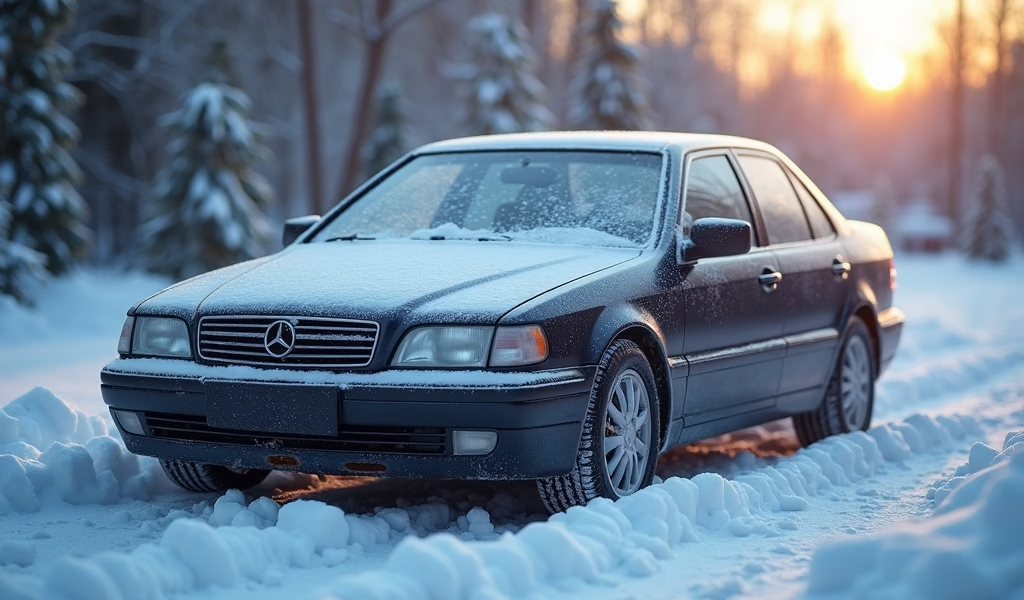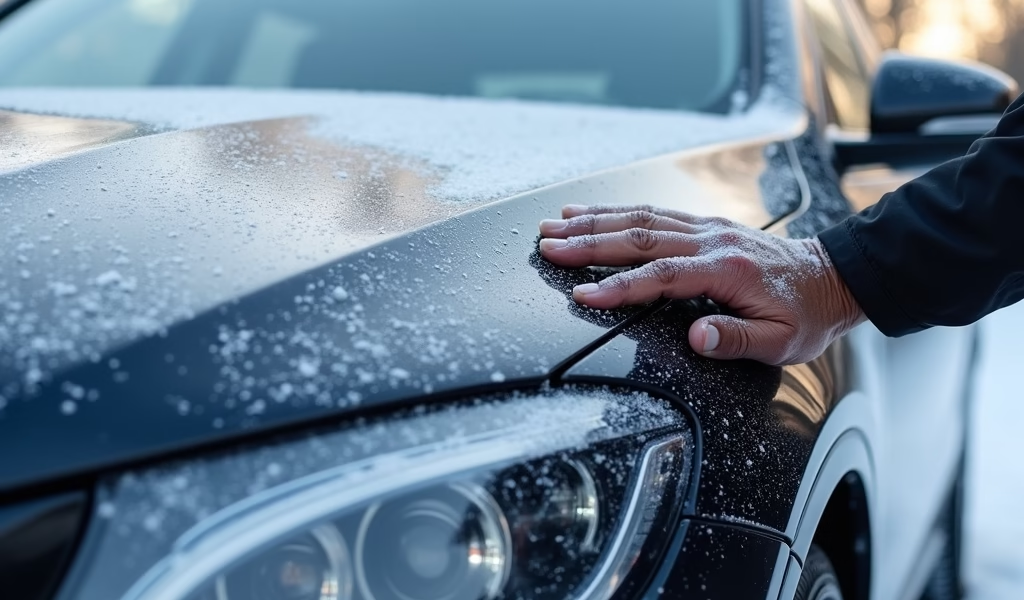Overview
This article outlines seven essential winter vehicle care treatments including proper washing techniques, protective waxing, undercarriage protection, tire maintenance, battery care, interior protection, and emergency kit preparation. These treatments help prevent salt damage and corrosion, maintain vehicle performance in freezing conditions, and extend your car’s lifespan while ensuring safety during winter driving.
Table of Contents
- Introduction to Winter Vehicle Care
- Why Snow Car Care Matters
- Treatment 1: Proper Winter Washing Techniques
- Treatment 2: Protective Waxing and Sealants
- Treatment 3: Undercarriage Protection
- Treatment 4: Tire and Wheel Care
- Treatment 5: Battery Maintenance
- Treatment 6: Interior Protection
- Treatment 7: Emergency Kit Preparation
- Conclusion
- Frequently Asked Questions
Introduction to Winter Vehicle Care
When winter arrives with its frosty embrace, your snow car needs more than just a running engine to tackle the challenges ahead. As someone who’s spent decades under the hood in all weather conditions, I can tell you that proper winter vehicle preparation isn’t just about convenience—it’s about safety and preserving your investment. Winter’s harsh combination of freezing temperatures, road salt, and moisture creates a perfect storm that can damage your vehicle’s exterior, undercarriage, and mechanical components.
Throughout my years working as an automotive technician in some of the coldest regions of the country, I’ve developed and refined these seven proven treatments that will keep your vehicle performing reliably throughout the snow season. These aren’t just quick fixes; they’re comprehensive protective measures that address the unique challenges winter presents to your vehicle. Whether you own the best car for snow or are making do with a less winter-ready vehicle, these treatments will significantly extend your car’s lifespan and improve your winter driving experience.
Let’s dive into these essential snow car care strategies that go beyond the basics, providing you with professional-grade protection that makes a noticeable difference when the temperature drops.
Why Snow Car Care Matters
Before we jump into specific treatments, it’s worth understanding exactly what we’re up against during winter months. Road salt and de-icing chemicals, while essential for safe roadways, are highly corrosive to your vehicle’s metal components. These substances accelerate rust formation, particularly on the undercarriage, brake lines, and exhaust system. According to AAA’s research, road salt causes over $3 billion in vehicle rust damage annually in the United States alone.
Additionally, extreme temperature fluctuations cause materials to expand and contract, potentially leading to premature cracking and wear. Moisture that seeps into crevices can freeze, expand, and force components apart or create pathways for corrosion to begin. This isn’t just about cosmetics—these issues directly impact your vehicle’s safety systems and structural integrity.
Proper snow car maintenance also delivers practical benefits beyond preservation. Well-maintained vehicles are:
- More fuel-efficient, saving you money throughout winter
- Less likely to break down in dangerous cold conditions
- Better equipped to provide reliable traction and handling
- More likely to retain resale value over time
In my experience, vehicles that receive dedicated winter care typically require fewer major repairs and last 3-5 years longer than those that don’t. That translates to thousands of dollars saved and greater peace of mind during winter travels. Let’s explore how to achieve this with our first proven treatment.

Treatment 1: Proper Winter Washing Techniques
Regular washing is your first line of defense against winter’s assault on your snow car, but winter washing requires a different approach than summer maintenance. The goal is to remove corrosive salt and grime without introducing additional moisture that could freeze in problematic areas.
When temperatures hover around freezing, opt for professional car washes with undercarriage spray options. These facilities typically have heated bays and equipment designed to thoroughly clean hard-to-reach areas without causing water to pool in door jambs and seals. Many also apply a final rinse with warmed water that evaporates more quickly than cold water would.
If you’re washing at home during a mild winter day (above 40°F), follow these professional techniques:
- Pre-rinse thoroughly with a strong spray to dislodge salt and debris
- Use a two-bucket method—one for soapy water, one for rinsing your mitt—to prevent scratching
- Clean from top to bottom, leaving wheels and rocker panels for last to avoid cross-contamination
- Pay special attention to wheel wells, where road salt accumulates heavily
- Dry thoroughly with microfiber towels, focusing on door jambs, trunk seals, and other water-collection points
The frequency of washing matters tremendously. During heavy salt application periods, washing every 7-10 days provides optimal protection. Remember that a quick rinse between full washes can still remove a significant amount of salt without requiring a complete detail. Many vehicles designed for snow have better rust protection from the factory, but even these require regular cleaning to maintain their advantage.
Treatment 2: Protective Waxing and Sealants
A proper protective barrier between your paint and winter’s elements provides crucial defense against salt spray, acidic precipitation, and road grime. This isn’t just about keeping your car looking good—it’s about preventing corrosion from getting a foothold on your vehicle’s exterior.
Before winter fully sets in, apply a high-quality synthetic wax or paint sealant. These modern formulations last significantly longer than traditional carnauba waxes and provide superior protection against the harsh conditions your snow car will face. The optimal time for application is fall, when temperatures are still moderate and you can properly prep the surface.
For maximum protection, consider this professional-grade application process:
- Start with a clay bar treatment to remove embedded contaminants
- Apply a paint sealant as your base layer of protection (these typically last 6-8 months)
- Top with a quality carnauba wax for additional hydrophobic properties and depth of shine
- Don’t forget often-neglected areas like door jambs, hood and trunk edges, and around emblems
If you’re dealing with an older vehicle or one with compromised paint, ceramic coatings provide the ultimate protection. While more expensive and typically requiring professional application, these advanced silicon dioxide-based protectants create a semi-permanent barrier that can last 2-5 years with proper maintenance. They excel at repelling water, preventing salt adhesion, and maintaining the surface integrity of your vehicle.
During mid-winter, apply a spray-on “wax booster” after washes to maintain protection without needing to perform a full waxing process. These quick-application products help extend the life of your base protection and can be applied in just minutes, even in cold temperatures.
Treatment 3: Undercarriage Protection
The underbody of your snow car faces the worst winter abuse, yet remains the most neglected area in most maintenance routines. Road salt, slush, and debris are constantly sprayed against exposed metal components, creating ideal conditions for accelerated corrosion. Protecting this vulnerable area requires specialized treatments and regular maintenance.
Oil-based undercoating provides exceptional protection by creating a water-resistant barrier that prevents salt from contacting metal surfaces. Many professional shops offer this service before winter begins. The coating adheres to frame rails, floor pans, and suspension components, actively displacing moisture and neutralizing corrosive elements.
For DIY enthusiasts, several quality options exist:
- Fluid film applications that can be sprayed at home with basic equipment
- Rubberized undercoating sprays for areas needing abrasion protection
- Wax-based protectants that harden to form a durable barrier
Focus your protection efforts on these critical undercarriage areas:
- Frame rails and crossmembers, which provide structural integrity
- Brake lines and fuel lines, which are thin and particularly vulnerable
- Suspension mounting points, where salt can accumulate in crevices
- Floor pan seams and drain holes, which collect moisture
Beyond coating applications, regularly flushing the undercarriage is essential. Many commercial car washes offer undercarriage spray options, which Consumer Reports identifies as one of the most effective ways to remove accumulated salt and prevent long-term damage. For comprehensive protection, combine professional undercoating with bi-weekly undercarriage rinses throughout winter.
Treatment 4: Tire and Wheel Care
Your vehicle’s tires and wheels bear the brunt of winter’s assault, directly contacting snow, slush, salt, and ice. Proper care ensures not only better performance but also prevents costly damage to these essential components. Starting with the right equipment makes all the difference in how your snow car handles winter conditions.
Winter-specific tires are the foundation of snow car preparation. These specialized tires feature compounds that remain flexible in cold temperatures and tread patterns designed to evacuate snow while providing maximum grip. Even the most capable snow cars perform dramatically better with proper winter tires. Studies from the Tire and Rubber Association of Canada show that winter tires can reduce stopping distances by up to 30% compared to all-seasons in snow and ice conditions.
Beyond tire selection, regular maintenance throughout winter includes:
- Weekly pressure checks (cold temperatures reduce pressure by approximately 1 PSI for every 10°F drop)
- Rotation every 5,000 miles to ensure even wear patterns
- Regular cleaning of wheels to remove corrosive brake dust and road salt
- Application of wheel sealant to create a protective barrier against salt damage
For aluminum alloy wheels, which are particularly vulnerable to corrosion from road salt, apply a dedicated wheel sealant before winter begins. These polymer-based products create a hydrophobic barrier that prevents brake dust and salt from bonding to the wheel surface. For maximum protection, reapply every 4-6 weeks throughout winter.
Don’t overlook your tire sidewalls either. Apply a silicone-based tire protectant to prevent cracking and deterioration from salt exposure. Unlike glossy tire dressings, winter tire protectants penetrate the rubber to prevent drying and cracking without creating a slippery surface that could transfer to your hands or clothing.

Treatment 5: Battery Maintenance
Cold weather is particularly hard on automotive batteries, and nothing ruins a winter morning faster than a vehicle that won’t start. Battery capacity can drop by up to 50% in freezing temperatures, making proper maintenance absolutely crucial for reliable winter operation of your snow car.
Begin winter preparation with a comprehensive battery inspection and load test. Even batteries that perform adequately in warm weather may fail when temperatures plummet. A professional load test measures the battery’s ability to deliver current under load, providing a reliable prediction of winter performance. Most automotive shops and parts stores offer this service free or at minimal cost.
For optimal battery health, implement these professional maintenance steps:
- Clean battery terminals and connections using a wire brush and baking soda solution
- Apply terminal protectant spray or petroleum jelly to prevent corrosion
- Check and tighten all battery connections to ensure good electrical contact
- For accessible batteries, check electrolyte levels and add distilled water if necessary
Consider investing in a battery maintainer for vehicles that sit for extended periods. Unlike simple trickle chargers, modern battery maintainers use intelligent microprocessors to monitor battery condition and adjust charging accordingly. This prevents overcharging while keeping the battery at optimal voltage during periods of non-use.
If your battery is more than three years old, replacement before winter begins may be the most cost-effective strategy. According to data from the American Automobile Association, battery failures are the number one cause of winter roadside assistance calls, with batteries failing most frequently during the first cold snap of the season.
Treatment 6: Interior Protection
Your snow car’s interior faces unique challenges during winter months, from salt-stained carpets to fogged windows and damaged upholstery. Proper interior protection prevents permanent damage while creating a more comfortable driving environment during harsh weather.
High-quality winter floor mats are your first line of defense against the slush, salt, and grime tracked in on boots and shoes. Look for deep-channeled designs that contain melting snow rather than allowing it to seep into carpeting. Rubber or thermoplastic mats significantly outperform carpet mats in winter conditions, offering better water containment and easier cleaning.
Beyond flooring protection, implement these interior preservation strategies:
- Apply fabric protectant to seats and carpets to repel water and prevent salt staining
- Treat leather surfaces with a conditioner containing UV protection to prevent drying and cracking
- Use anti-fog treatment on interior glass surfaces to maintain visibility
- Place silica gel packets in strategic locations to absorb excess moisture
Window fog is a persistent winter problem caused by the temperature differential between the cold exterior and warm interior. Beyond using your defrosters properly, apply an anti-fog treatment to interior glass surfaces. These products create a hydrophilic surface that prevents water vapor from forming visibility-obscuring droplets. For a budget-friendly alternative, a solution of one part vinegar to three parts water applied with a microfiber cloth works surprisingly well.
Don’t overlook your weatherstripping—these rubber seals around doors and windows prevent moisture intrusion but become brittle in cold weather. Apply a silicone-based rubber protectant to keep these components pliable and functioning properly throughout winter. This simple step prevents door freezing and reduces interior moisture problems.
Treatment 7: Emergency Kit Preparation
Even with meticulous maintenance, winter conditions can create emergency situations. A properly equipped snow car emergency kit can transform a potentially dangerous situation into merely an inconvenience. Based on decades of winter driving experience, I’ve refined an emergency kit that addresses the most common winter roadside scenarios.
Your comprehensive winter emergency kit should include:
- Folding shovel and traction aids (sand, cat litter, or commercial traction mats)
- Jumper cables or portable jump starter with USB charging capability
- LED flashlight with extra batteries
- Thermal blanket and extra warm clothing
- Non-perishable food and water
- First aid supplies
- Ice scraper and snow brush
- Basic tool kit including pliers, screwdrivers, and adjustable wrench
Modern portable jump starters deserve special mention. These compact lithium-ion devices can jump-start most vehicles multiple times on a single charge, while also providing power for mobile devices. They eliminate the need for another vehicle to provide a jump start, making them invaluable during isolated breakdowns.
Beyond physical supplies, prepare digitally by downloading offline maps of your regular travel areas and roadside assistance apps. Many insurance companies and auto clubs offer specialized winter emergency assistance. Program these numbers into your phone and keep a physical copy in your glove compartment as backup.
Remember that communication is crucial during winter emergencies. Keep a phone charger in your vehicle at all times, and consider a backup power bank for extended situations. Let someone know your route and expected arrival time when traveling in severe winter conditions, especially in rural areas.
Conclusion
Taking proper care of your snow car isn’t just about aesthetics—it’s about safety, reliability, and protecting your investment from winter’s harsh effects. The seven treatments we’ve covered form a comprehensive approach that addresses both prevention and preparation. From undercarriage protection that prevents costly structural damage to emergency kits that ensure you’re ready for unexpected situations, each element plays a vital role in your winter driving experience.
Remember that consistency is key. Many of these treatments require regular maintenance throughout the winter season rather than one-time application. Establish a winter maintenance schedule that includes regular washing, battery checks, and tire pressure monitoring. Your vehicle will reward you with better performance, improved safety, and extended lifespan.
As a final thought, consider that proper winter vehicle care is ultimately an investment rather than an expense. The modest time and resources dedicated to these preventative measures can save thousands in repair costs while providing priceless peace of mind during challenging winter conditions. Your snow car deserves this level of care—and you deserve the confidence that comes from knowing your vehicle is properly protected.
Frequently Asked Questions
How often should I wash my car in winter?
Wash your car every 7-10 days during heavy salt application periods. A quick rinse between full washes can still remove significant amounts of salt.
Are winter tires really necessary if I have all-wheel drive?
Yes, winter tires improve stopping distance by up to 30% compared to all-seasons, regardless of drivetrain. All-wheel drive helps you accelerate, but doesn’t significantly improve braking or cornering.
What’s the best way to protect my car’s paint from road salt?
Apply a high-quality synthetic wax or paint sealant before winter, then maintain with spray wax after washes. Ceramic coatings offer the ultimate protection but require professional application.
How can I prevent my car doors from freezing shut?
Apply silicone spray or rubber conditioner to weatherstripping around doors and windows. Avoid using water-based lubricants as they can freeze.
What should I do if my battery dies in cold weather?
Use jumper cables or a portable jump starter to get your vehicle running, then drive for at least 20 minutes to recharge. Have your battery tested as soon as possible, as cold-weather failure often indicates it needs replacement.

